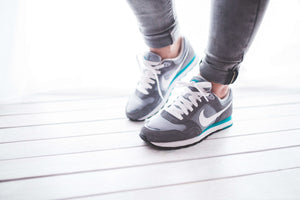
Have you ever done a really hard workout at the gym, and then later find yourself limping around with really stiff muscles? It could be running, lifting heavy weights, high intensity workouts, crossfit, soccer, or any other high cardio sport. Whether we are working out or sitting at the computer all day, we may find sore muscles or heavy legs because blood is not circulating as much as it should.
Basically when we do high intensity training or exercise, our muscles get inflamed (inflammation). Although it may feel nice to have stiff bulging muscles (for the men, especially), long term the muscles need to repair as you 'get ripped.' Here are a few practical ideas on how to relieve sore muscles.
The largest muscle in the body by volume is the gluteus maximus, the 'glute.' However, the muscle on the outside of the thigh, is the iliotibial band, the IT band. Many runners have problems with it, and suffer from IT band friction syndrome or IT band syndrome. This is a key muscle that can cause stiffness in the legs and cause injury to the knees, especially when hard core exercising, especially running. Use a foam roller to roll out this part of the leg so that the blood can circulate better to keep the muscle from stiffening. We cannot emphasize enough how important this is especially if you do long runs. When the muscles are tight, they are inflamed (inflammation), which is why taking steps for muscle recovery is important.
If you do not usually foam roll, when you first start you you most likely will experience A LOT of sore pain (not sharp pain). This means the muscle is very tight and needs to be rolled out in order to heal. Since all our muscles are connected, if parts of your muscles are left tight, the blood flow will be reduced, leading to muscle weakness years down the road or more likely injury due to stiff muscles.
We even have a work out for you right here with the foam roller! Watch below.
If you have some history of stiff muscles due to not doing things to relieve sore muscles, massage is key, but not any massage therapist will do. A sports therapy massage will effectively relieve muscle tightness and muscle pain. This is not for relaxation during the massage, your relaxation will come after the muscles start to loosen (takes a few days)! It is best to find a massage therapist who focuses on sports therapy, and during the massage session, it may be very sore painful; however, over multiple sessions, you will find your muscles getting major relief. Muscles that have a good blood circulation are ones that are very loose. This is not fat, they are muscles that are completely circulating with blood flow. After massage sessions, be sure to drink enough water and stay hydrated since massages get rid of toxins in the body.
Foods such as baobab superfruit, avocado, spinach, sweet potato, bananas, and mango are high contenders for potassium.
Avocado: 1 whole: 975 milligrams (21 percent DV)
Spinach: 1 cup cooked: 839 milligrams (24 percent DV)
Sweet Potato: 1 large: 855 milligrams (24 percent DV)
Banana: 1 large: 487 milligrams (14 percent DV)
Mango: 1 medium 564 milligrams (12 percent DV)
Baobab: 2 tablespoons 330 milligrams (7 percent DV)
Keep in mind, the baobab daily value would be much higher, if we compared similar weights as the fruits and vegetables. Baobab superfruit is still a star for potassium because one does not have to consume much to get a good deal of benefit.
Potassium is known as an electrolyte and works alongside with sodium to maintain a normal blood pressure. Potassium helps maintain fluid balance in the body and transmit electrical pulses for proper nerve and muscle function. How much potassium do we need a day? Daily intake is 4,700 mg/day according to the FDA.
Magnesium is also vital to our health, and most people do not get an adequate amount of magnesium. Too little potassium, calcium or magnesium in our diets can contribute to muscle leg cramps, muscle soreness or muscle leg swellings.
References: FDA, Mayo Clinic
